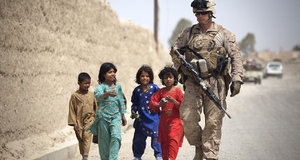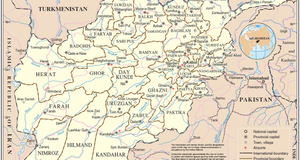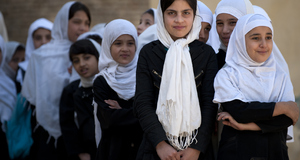From Cornell International Affairs Review VOL. 3 NO. 2Influence Operations as Counterinsurgency: A Strategy of DivisivenessGiven the long and complex history of the Taliban in Afghanistan, there is not a golden key to disaffecting the population as there was in Peru. Perhaps a better way to target the Taliban's support is with a more comprehensive approach. According to Kilcullen, "the Taliban adopted a five-line information strategy in early 2006" emphasizing the importance of the Taliban party, Pashtun nationalism, the poppy economy, Shari'a law, and the emirate as a form of government.16 A potential key to disaffection lies in how these priorities are ordered. It is likely that the average Pashtun would order these differently than Taliban leadership. Kilcullen calculates that twentyfive percent of Afghan insurgents belong to the "‘core' Taliban" while most of the remaining seventy-five percent "are local, part-time guerrillas who cooperate on a temporary, ad hoc basis."17 If this is accurate, it is likely that the "part-time" seventy-five percent have different priorities than the "core" or "fulltime" twenty-five percent, assuming, quite pessimistically, that they all have basically the same set of interests corresponding to "the five-line information strategy." This is not to say that either group is a unitary constituency, but there are some conclusions we can draw from this division. As the Taliban's support is mainly Pashtun, it is likely that the "parttime" seventy-five percent is mostly Pashtun. These Pashtuns who fight on their own terms, whom Kilcullen might designate "accidental guerrillas," probably support the Taliban more for the ‘Pashtunistan' nationalist platform, as it is more specific to their Pashtun identity, than for the conservative Islamic platforms. This explains their part-time commitment. The fulltime twenty-five percent, identified as "‘core' Taliban," probably value the conservative Islamic principles of the Taliban more specific to their Taliban identity.18 Moreover, Kilcullen points out that "Eleven percent consider poppy cultivation legitimate under all circumstances."19 If this eleven percent also fits more into the core Taliban portion of the population, then the poppy is also prioritized differently between the two groups. An influence operation highlighting these disparate priorities in conjunction with Afghan government policy designed to co-opt and integrate the "part-time" majority could substantially weaken support for the Taliban in Pashtun regions. Even a resulting minor hit among the Taliban's main support base would hugely improve U.S. forces' and the Afghan government's position in the conflict. Granted, we are unlikely to defeat the Taliban altogether with an information operation. Progress made through influence operations of this kind, however, would improve the Afghan government's position and facilitate the reintegration of Taliban constituents. It should be mentioned that the Taliban uses tactics of intimidation to gain and maintain popular support. Galula explains that potential opposition to the insurgency "cannot emerge as long as the threat [of intimidation] has not been lifted to a reasonable extent."20 In this case, therefore, the physical operations already underway are necessary to enable the success of the influence operations. Conclusion"As for me, I set out to prove a theory of counterinsurgency warfare, and I am satisfied that it worked in my small area. What I achieved in my first six or eight months in the Djebel Aissa Mimoun was not due to magic and could have been applied much earlier throughout Algeria." – David Galula, Pacification in Algeria, 1956-1958 The global nature of insurgent movements like al Qaeda makes them less likely to fully and accurately represent the interests of specific local populations. This makes them especially vulnerable to the approach outlined above. Much like the U.S. and other counterinsurgent forces, however, they adapt to the cultural landscape of their target populations with time. As a result, influence operations designed to highlight disparate interests between an insurgency and their target population are most effective when implemented early. In trying to clarify how to win a counterinsurgency effort that is already underway, many counterinsurgency theorists unintentionally demonstrate how to preemptively weaken insurgent groups. While the use of influence operations before physical operations is preferable in counterinsurgency warfare, anything resembling a preemptive effort to subvert an enemy organization is subject to comparisons to Cold War-era covert operations. As Mackay and Tatham point out, however, while influence operations were organized from the top down and extremely centralized during the Cold War due to the sensitivity of the situation, "in counterinsurgency decentralization is absolutely essential."21 This mirrors observations in Major-General Flynn's recent report on "Fixing Intel" in Afghanistan. Flynn emphasizes the importance of unclassified information and bottom-up operational design in counterinsurgency intelligence.22 The decentralized nature and largely unclassified content of influence and related intelligence operations in counterinsurgency minimizes the likelihood that these operations would be as controversial and suspect as their Cold War counterparts. We can also conclude that how long the insurgency has been among the people spreading their propaganda is of great importance. Specifically, there appears to be a notable difference between Iraq and Afghanistan. While in Iraq extremism rose primarily after the American invasion, in Afghanistan extremists had been present and spreading their message since the SovietAfghan War. This corresponds directly to the strength of the ties between the insurgency and the population, and, therefore, the ease with which the insurgency can be politically separated from the population. This conclusion also lends support to the use of somewhat preemptive counterinsurgency influence operations in a nation like Yemen where an insurgent group is gaining momentum and support. The ability to implement intelligent influence operations is essential to counterinsurgency. Although it is unorthodox, the "highlighting the difference" approach was effective in Peru and appears to have a place in Iraq and Afghanistan as well. While preemptive actions should always warrant a certain amount of criticism, due to their obvious risks and implications, the "highlighting the difference" approach would probably be most effective if if it is used more preemptively. That is not to say a huge web of preemptive and covert influence operations is necessary to avoid future wars with organizations like al Qaeda. However, public diplomacy efforts in nations with burgeoning Islamist insurgencies could be stepped up without warranting accusations of interventionism and manipulation. Whether or not the U.S. chooses to institutionalize the lessons of counterinsurgency it has picked up in Iraq and Afghanistan, hopefully it will not forget the lesson of creativity. It would indeed be a weakness of ours if the U.S. only acknowledged and targeted enemies' physical vulnerabilities. Every war has a dimension outside of the traditional battlefield. Whether it's an urban battlefield or a cyber-war, the search for a victory to be achieved outside of the realm of traditional kinetic operations should be welcomed not scorned. Endnotes
Photos courtesy of:
Suggested Reading from Inquiries Journal
Inquiries Journal provides undergraduate and graduate students around the world a platform for the wide dissemination of academic work over a range of core disciplines. Representing the work of students from hundreds of institutions around the globe, Inquiries Journal's large database of academic articles is completely free. Learn more | Blog | Submit Latest in International Affairs |

















